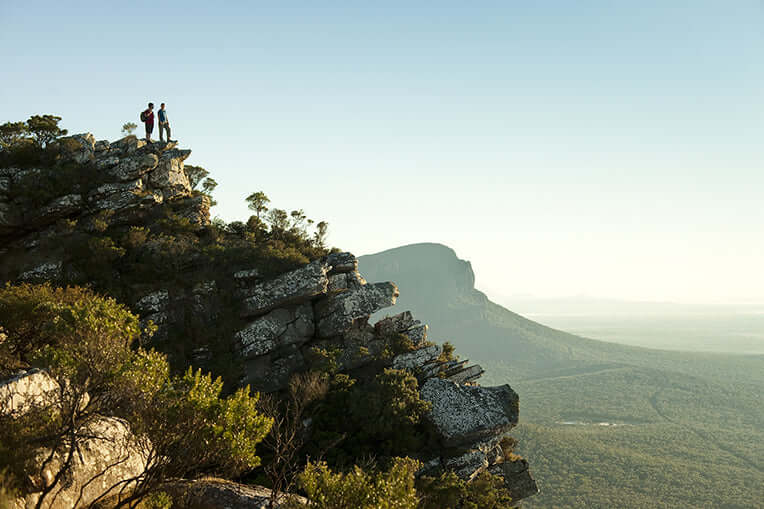Australia’s a continent of micro-climates and mega-landscapes. Pick the right season and a trek becomes transcendent; pick the wrong one and you’re doing the cha-cha with heat, storms, or leeches. This guide maps the best multi-day walks in Australia by season, with plain-English weather notes, difficulty cues, and what to pack so the only thing that melts is your heart at the view.
Quick tip: browsing Australian Adventures lets you filter small-group, multi-day walks and 4WD combos by time of year and difficulty.
How to Use This Guide (60 seconds)
-
Seasons: Australia’s meteorological seasons—Summer (Dec–Feb), Autumn (Mar–May), Winter (Jun–Aug), Spring (Sep–Nov).
-
Difficulty shorthand:
Easy = formed trails, light packs, <12 km/day.
Moderate = mixed terrain, some ascents, 12–20 km/day.
Challenging = steep/remote, rough underfoot, >18 km/day or off-track sections. -
Always check: local fire warnings, track closures, cyclone updates (northwest), and tidal charts for coastal sections.
Summer (Dec–Feb): Alpine highs & sea-breeze trails
Why now: Long daylight hours. Cooler alpine temps. Coastal breezes take the edge off heat.
Watch for: Heat spikes inland, afternoon storms, bushfire alerts in southern states.
Top picks
-
Australian Alps & High Country (VIC/NSW) – Alpine meadows, granite tors, crisp mornings. Difficulty: Moderate. Daily kms: 12–18.
Good for: Mount Buffalo circuits, Bogong High Plains loops, Kosciuszko ridgelines. -
Tasmanian Highlands & Coasts – Peak season for safer river levels and stable weather windows. Difficulty: Moderate–Challenging. Daily kms: 10–15.
Good for: Central Plateau traverses, coastal cliffline routes, hut-supported classics. -
Southern Coastal Walks (SA/VIC/NSW) – Ocean breeze, dawn starts, swims at lunch. Difficulty: Easy–Moderate. Daily kms: 10–20.
Good for: Long ocean-edge itineraries with beach/forest mix.
Pro moves
-
Start early, siesta mid-arvo shade, finish by golden hour.
-
Wide-brim hat, sun gloves, electrolyte tabs, and 2–3L hydration capacity.

Autumn (Mar–May): Goldilocks season—mild, stable, glorious
Why now: Shoulder-season magic: settled weather, lower fire risk, fewer crowds.
Watch for: Cold snaps in Tasmania; early darkness by late May.
Top picks
-
Tasmania (state-wide) – Crisp air, fiery fagus, good traction underfoot. Difficulty: Moderate–Challenging. Daily kms: 10–15.
Good for: Coastal peninsulas, alpine lake districts, mixed forest-coast routes. -
Victorian Alps & Gippsland – Cooler climbs, bug-free bliss. Difficulty: Moderate. Daily kms: 12–18.
Good for: Multi-day ridgeline traverses and river-valley loops. -
NSW Tablelands & Blue Mountains – Waterfalls pumping, temps dialed in. Difficulty: Easy–Moderate. Daily kms: 10–16.
Good for: Cliff-top tracks, canyon-rim circuits, forested multi-days.
Pro moves
-
Layer up: lightweight fleece + wind shell.
-
Stable footing ≠ easy: autumn leaf-litter can hide roots and rocks.
Winter (Jun–Aug): Desert days, Top End dry, red-rock wonderlands
Why now: Cool, clear conditions in regions that are steamy or scorching the rest of the year.
Watch for: Chilly desert nights; cold fronts in southern states; snow in the Alps.
Top picks
-
Red Centre & Desert Tracks (NT/SA/WA) – Big-sky walking without heat stress. Difficulty: Moderate–Challenging. Daily kms: 12–20.
Good for: Gorge country, ochre ranges, long red-sand sections and 4WD-assisted point-to-points. -
Top End & Kimberley (NT/WA) – Prime dry-season window: waterfalls accessible, humidity sane. Difficulty: Moderate. Daily kms: 10–15.
Good for: Plateau walks to swimming holes (croc safety protocols apply), sandstone escarpments, boab-dotted savannah. -
Southern Short Breaks – Pick windows between fronts for coastal gems. Difficulty: Easy–Moderate. Daily kms: 8–14.
Good for: Weekenders with hearty cabins or cosy lodges.
Pro moves
-
Pack a warm sleep system (comfort rating near 0–5°C).
-
Headlamp + spare batteries: nights are long, stars are outrageous.
Spring (Sep–Nov): Wildflowers, whales, and shoulder-season sweet spots
Why now: Warmer days, cool nights, long light, and WA wildflower season.
Watch for: Variable weather in the south; early heat spikes late spring inland.
Top picks
-
Western Australia (Southwest & Coral Coast) – Wildflower carpets + coastal bluff walks. Difficulty: Easy–Moderate. Daily kms: 10–18.
Good for: Limestone headlands, turquoise coves, and iconic clifftops. -
NSW/VIC Coasts – Breezy and bright without peak-summer heat. Difficulty: Easy–Moderate. Daily kms: 10–20.
Good for: Cliff-line day stacks into a compact multi-day, whale sightings shoulder-season. -
Tasmania Spring Windows – Longer days, alpine thaw. Difficulty: Moderate–Challenging. Daily kms: 10–15.
Good for: Mixed forest-moor circuits with snow patches fading.
Pro moves
-
Sun & wind protection still matter—spring can bite.
-
Shoulder season = flexible logistics: ferries, shuttles, and park bookings open up.

Difficulty & Daily Distance: Choose with your body, not your ego
-
Terrain > distance. A “short” 12 km on roots, rock-hopping and sand can feel longer than 18 km of groomed path.
-
Pack weight compounds fatigue. If carrying full kit, aim 12–16 km/day for moderate terrain; supported trips can stretch to 18–22 km/day.
-
Ascent matters. Add ~1 hour for every 300–400 m of climbing, depending on fitness.
-
Group tours reduce decision fatigue. Logistics, navigation, water points, and camp setup are handled—more energy for the actual walking.
What to Pack (Multi-Day Essentials)
Footwear & clothing
-
Broken-in boots or trail shoes, lightweight camp shoes
-
Moisture-wicking layers, warm mid-layer, waterproof shell
-
Wide-brim hat, sun gloves, sunglasses (category 3+)
Safety & nav
-
2–3L hydration capacity + electrolytes
-
Map/GPS + power bank; whistle; compact first-aid kit
-
PLB or satellite messenger for remote routes
Sleep & camp (if self-supported)
-
Season-appropriate sleeping bag & insulated mat
-
Lightweight tent/tarp; headlamp + spare batteries
-
Stove/fuel (check fire restrictions), meals, snacks
Eco & comfort
-
Reef-safe sunscreen, insect repellent, biodegradable soap
-
Microfibre towel, toilet kit (incl. TP & trowel where required)
-
Small rubbish bag—pack out what you pack in
On guided small-group tours, many items (tents, mats, meals, safety comms) are provided—check the What’s Included section for each itinerary.
Weather & Safety at a Glance
-
Heat & sun: Early starts, long sleeves, electrolytes.
-
Cold & wind: Windproof outer layer; keep core warm and dry.
-
Rain & rivers: Waterproofing for pack and feet; never cross flooded creeks.
-
Fire & closures: Check park alerts the day before and morning of departure.
-
Crocodile country (Top End): Only swim where signed safe; follow guide instructions to the letter.
-
Leave No Trace: Stay on track, protect fragile dunes and alpine moss; respect cultural sites.

Responsible Travel, Real Impact
Adventure should feel good during and after the trip. Small-group tours minimize footprint; booking through Australian Adventures supports landscape restoration projects—so the places that change you get a little love back.
FAQs
What’s the best month to hike Australia?
Depends on region. Winter for the Red Centre/Top End, Autumn/Spring for southern states, Summer for alpine areas and sea-breeze coastal tracks.
How do difficulty ratings work?
They combine terrain, ascent, exposure, and daily distance. If unsure, choose a moderate itinerary first; confidence beats bravado.
Do multi-day tours include gear and meals?
Many guided tours include most essentials (meals, camping gear, safety comms). Always check What’s Included / Not Included on the listing.
Are flights and pre/post-tour stays included?
Typically not included. Travellers are responsible for getting to/from the tour start and end points.
Ready to Plan?
Browse Australian Adventures to compare Guided Walks and 4WD-assisted treks by season, difficulty, and vibe. Pick the window that flatters the landscape—and go make some trail-dusted memories.




